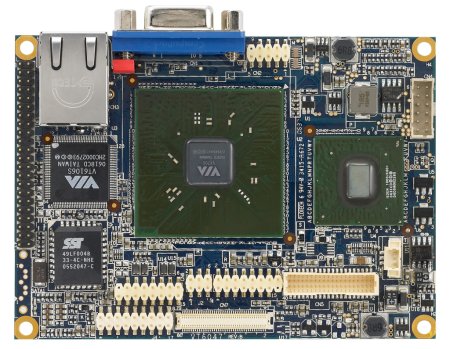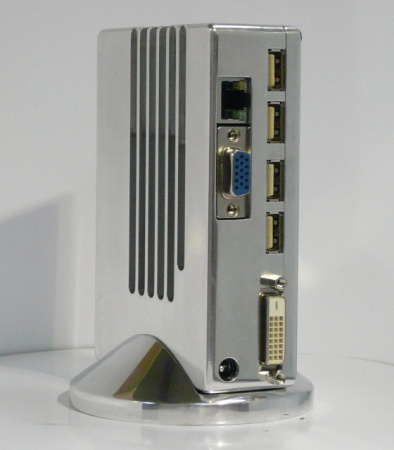Tiny PCs use pico-ITX main board
Nov 28, 2007 — by LinuxDevices Staff — from the LinuxDevices Archive — 3 views The U.K.-based company Sharp and Tappin Technology (STTech) is readying two PCs based on Via's recently introduced pico-ITX motherboard. The picoPC1 and picoPC2 measure as little as 5 x 3.4 x 1.5 inches, and feature separately available cases fashioned from billet aluminum, according to the company.
The U.K.-based company Sharp and Tappin Technology (STTech) is readying two PCs based on Via's recently introduced pico-ITX motherboard. The picoPC1 and picoPC2 measure as little as 5 x 3.4 x 1.5 inches, and feature separately available cases fashioned from billet aluminum, according to the company.
(Click here for a larger view of the picoPC and coffee mug)
digg this story |
The systems will be available with STTech's own “customized, optimized version of Gentoo Linux,” according to spokesman Ben Sharp. Sharp added, “We are considering/evaluating a few other distros as possibilities to ship with the PicoPC range, including gOS” (gOS story).
Both systems use Via's Epia PX10000G main board. When released in May, the PX10000G was touted as the “the smallest complete x86 mainboard in the industry.”
Pico-ITX format boards occupy half the surface area of nano-ITX boards, and a quarter that of boards based on the now 5-year-old mini-ITX standard. This miniaturization has been enabled in part by an 82 percent real estate reduction of Via's chipsets: from 50 x 50mm for mini-ITX's original “Socket 370” processors, to just 21 x 21mm for the “nanoBGA” package used in Via's current-generation C7 processors.

Via's Epia PX series mainboards measure 3.9 x 2.8 inches
(Click to enlarge)
In its picoPC1 and picoPC2, STTech has housed the main board in aluminum cases that the company says can be high-gloss anodized in a variety of colors. The picoPC1 features 2GB, 4GB, or 6GB of flash memory as its mass storage, and is just 5 x 3.4 x 1.5 inches. The picoPC2 provides room for a 2.5-inch hard drive, measuring 5 x 3.4 x 1.9 inches overall.
The Epia PX10000G — and, hence, the STTech PCs — is based on a 1GHz Via C7 processor. The board also integrates Via's VX700 companion chip, which melds the features of Via's VN800 northbridge and VT8237 southbridge into a single “system media processor.” The VX700 features Via's UniChrome Pro II IGP 3D/2D graphics core, along with MPEG-2/-4 and WMV9 decoding acceleration hardware. The board provides an SODIMM socket that accommodates up to 1GB of DDR2 533 SDRAM memory.

Sharp and Tappin's picoPCs feature 6 USB ports and dual video outputs
Powered by an external 12VDC supply, the STT PCs have room for a variety of I/O, including both VGA and DVI video outputs, an RJ-45 LAN connector, and six USB ports. According to the company, the picoPC1 outputs 6:1 surround sound via four 3.5mm jacks, while the picoPC2 outputs 5:1 sound via three 3.5mm jacks. (These appear not to be installed on the pre-production units pictured.)
Sharp and Tappin lists the following key specifications for the picoPC1 and picoPC2:
- Processor/chipset:
- Via C7 clocked at 1GHz (in NanoBGA2 package)
- Via VX700 Unified Digital Media IGP chipset
- Integrated Via UniChrome Pro II 3D/2D AGP graphics with MPEG-2/4 and WMV9 decoding acceleration
- Via VT6106S 10/100Mbps Ethernet controller with power management functions
- Via VT1708A high definition audio codec
- Memory: DDR2 533 SODIMM socket; 512MB RAM standard, expandable up to 1GB
- Storage:
- picoPC1 — 2GB, 4GB or 8GB of flash
- picoPC2:
- 2GB, 4GB or 8GB of flash (optional)
- 40GB to 160GB hard disk drive (optional)
- I/O:
- 2 x USB 2.0 (front panel)
- 4 x USB 2.0 (back panel)
- 1 x DVI
- 1 x VGA
- 4 3.5mm jacks for 6:1 audio output (picoPC1)
- 3 3.5mm jacks for 5:1 audio output (picoPC2)
- 1 x LAN port
- 1 x 12V DC power input connector
- Dimensions:
- picoPC2 — 5 x 3.4 x 1.5 inches (125 x 85 x 37 mm)
- picoPC2 — 5 x 3.4 x 1.9 inches (125 x 85 x 48 mm)
Sharp and Tappin says it will ship the picoPC1 and picoPC2 “OS free,” with Linux, or with Windows XP. The devices should also be compatible with Windows XP Embedded.
Pricing was not stated, but the company says production units will ship in “mid to late December.” More details may be available on STTech's main website, here, or on a dedicated “PicoPC” website, here.
Additionally, the company plans to sell the cases from both systems separately, providing an alternative to the Serener GS-L08, which was touted as the “world's first” pico-ITX case when it shipped last month.
This article was originally published on LinuxDevices.com and has been donated to the open source community by QuinStreet Inc. Please visit LinuxToday.com for up-to-date news and articles about Linux and open source.